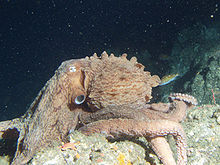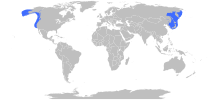- Enteroctopus dofleini
-
Giant Pacific Octopus 
E. dofleini observed off Point Piños, California, at a depth of 65 meters. Scientific classification Kingdom: Animalia Phylum: Mollusca Class: Cephalopoda Order: Octopoda Family: Octopodidae Genus: Enteroctopus Species: E. dofleini Binomial name Enteroctopus dofleini
(Wülker, 1910)
Distribution of E. dofleini Synonyms - Octopus punctatus
Gabb, 1862 - Octopus dofleini
Wülker, 1910 - Polypus dofleini
Wülker, 1910 - Octopus dofleini dofleini
(Wülker, 1910) - Polypus apollyon
Berry, 1912 - Octopus dofleini apollyon
(Berry, 1912) - Polypus gilbertianus
Berry, 1912 - Octopus gilbertianus
Berry, 1912 - Octopus apollyon
(Berry, 1913) - Octopus madokai
Berry, 1921 - Paroctopus asper
Akimushkin, 1963 - Octopus dofleini martini
Pickford, 1964
Enteroctopus dofleini, also known as the Giant Pacific Octopus or North Pacific Giant Octopus, is a large cephalopod belonging to the genus Enteroctopus. It can be found in the coastal North Pacific, usually at a depth of around 65 meters (215 ft). It can, however, live in much shallower or much deeper waters. It is arguably the largest octopus species, based on a scientific record of a 71 kg (156.5 lb) individual weighed live.[1] The alternative contender is the Seven-arm Octopus based on a 61 kg (134 lb) carcass estimated to have a live mass of 75 kg (165 lb).[2][3] However, there are a number of questionable size records that would suggest E. dofleini is the largest of all octopus species by a considerable margin.[4]
Contents
Size and description
The Giant Pacific Octopus, are distinguished from other species by their sheer size. Adults usually weigh around 15 kg (33 lb), with an arm span of up to 4.3 m (14 ft).[5] However, there are highly questionable records of specimens up to 272 kg (600 lb) in weight with a 9 m (30 ft) arm span.[6] The mantle of the octopus is spherical in shape and contains most of the animal's major organs. By contracting or expanding tiny pigment-containing granules within cells known as chromatophores in its tissue, an octopus can change the color of its skin, giving it the ability to blend in to the environment.
Diet
This species of octopus commonly preys upon shrimp, crabs, scallops, abalone, clams, and fish. Food is procured with its suckers and then crushed using its tough "beak" of chitin. They have also been observed in captivity catching Spiny dogfish (Squalus acanthias) of up to 3-4 feet in length.[7] Additionally, consumed carcasses of this same shark species have been found in Giant Pacific Octopus middens in the wild, providing strong evidence that these octopuses prey on sharks in their natural habitat. [8]
Predators
Marine mammals such as Harbor Seals, Sea Otters, and Sperm Whales depend upon the Giant Pacific Octopus as a source of food. The octopus is also commercially fished in the United States.
Life span and reproduction
The Giant Pacific Octopus is considered to be short-lived for an animal its size, with life spans that average only 3-5 years in the wild. To make up for its relatively short life span, the octopus is extremely prolific. It can lay up to 100,000 eggs which are intensively cared for by the females, who die protecting the eggs. Hatchlings are about the size of a grain of rice, and very few survive to adulthood.
During reproduction, the male octopus deposits a spermatophore (or sperm packet) more than 1 meter long. Large spermatophores are characteristic of octopuses in this genus.[4]
Conservation
Very little is known about the population of this solitary creature and the Giant Pacific Octopus is not currently under the protection of CITES or evaluated in the IUCN Red List.
See also
References
- ^ Cosgrove, J.A. 1987. Aspects of the Natural History of Octopus dofleini, the Giant Pacific Octopus. M.Sc. Thesis. Department of Biology, University of Victoria (Canada), 101 pp.
- ^ O'Shea, S. 2004. The giant octopus Haliphron atlanticus (Mollusca : Octopoda) in New Zealand waters. New Zealand Journal of Zoology 31(1): 7-13.
- ^ O'Shea, S. 2002. Haliphron atlanticus — a giant gelatinous octopus. Biodiversity Update 5: 1.
- ^ a b Norman, M. 2000. Cephalopods: A World Guide. Hackenheim, ConchBooks, p. 214.
- ^ Smithsonian National Zoological Park: Giant Pacific Octopus
- ^ High, W.L. 1976. The giant Pacific octopus. U.S. National Marine Fisheries Service, Marine Fisheries Review 38(9): 17-22.
- ^ http://video.google.com/videoplay?docid=-7004909622962894202
- ^ Walla Walla University Marine Invertebrates Key: Giant Pacific Octopus
External links
- CephBase: Enteroctopus dofleini
- Video of a giant octopus catching a shark
- Video of a giant pacific octopus in an aquarium
Edible mollusks Bivalves Atlantic jackknife • Atlantic surf • Geoduck • Grooved carpet shell • Hard clam • Horse • Mactra stultorum • Blunt gaper • Ocean quahog • Pacific razor • Pecten jacobaeus • Venus • California butterclam • Senilia senilis • Smooth clam • Soft-shell • Triangle shell • Tuatua • Japanese littleneck • Razor clam • Pod razor • Ensis (razor genus) • PaphiesBlue • Mediterranean • New Zealand green-lipped • California • Brown • Asian/Philippine green • Date • Mytilidae (mussel family)Auckland • Eastern • Olympia • Southern mud • Colchester native • Pacific • Portuguese • Windowpane • Rock • Sydney rock • Ostra chilena/Bluff • Gillardeau oysters • Crassostrea ("true oyster" genus)Gastropods Queen • DogBlack foot opihi/Haiwaiian • China • Common European • Rayed Mediterranean • Ribbed Mediterranean • Rustic • Turtle/Talc • Yellow foot opihiLandFreshwaterNeritesInkfish Spineless • BottletailChitons Chiton magnificus • Acanthopleura granulataRelated topics: Oyster farming • Land snail farming • Categories:- Octopodidae
- Animals that can change color
- Megafauna
- Animals described in 1910
- Edible molluscs
- Octopus punctatus
Wikimedia Foundation. 2010.


